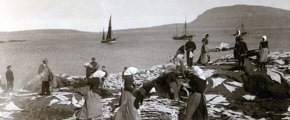Tusk (Brosme, Cusk)
The tusk is related to the ling and has a similarly elongated shape. Its meat is fine and textured with a mild sweet taste.
The tusk has a snowy white meat that turns opaque once cooked. It is a very versatile fish and can be prepared in several different ways – boiled, broiled, fried, sautéed and poached – with great success.
Tusk flesh is very firm and very dense. The density means that it takes longer to cook, but the meat will retain its firmness and texture when heated. This makes tusk ideal for soups. Tusk can be paired with a great variety of spices, flavours and vegetables to make a soup that is tailored to individual tastes.
Tusk is an oily and succulent fish with a mild sweet taste. The tusk’s moistness and tenderness also make it an excellent choice for use in any kind of fish pie.
Tusk is a lean fish and is especially rich in protein, vitamin B12 and selenium.
Biology
The tusk (Brosme brosme) is part of the ling family. It is long and slender, but a little rounder than other ling fish. It can grow up to 120 cm long but is usually around 40-90 cm when caught.
Tusk often travel in smaller schools and around the Faroe Islands, vessels usually fish for tusk alongside other types of ling fish. In the Faroe Islands tusk is called brosma.
Tusk has a dark grey colour on the back that lightens towards the sides and turns white on the stomach. They often have yellowish stipes on their sides and/or a golden hue to the entire skin.
Tusk have a very long dorsal fin that almost covers the entire back and goes all the way to the tail fin. The posterior fin is a little shorter, but also connects to the tail fin. The tusk’s fins are striped. They have a white outer ridge, while the rest of the fin is a light grey. Between the two segments there is a black line.
The tusk is a demersal fish that prefers hard and rocky sea floors, preying on crustaceans and other soft bodied invertebrates and molluscs. They can be found as deep as 1500 metres below the ocean surface but will usually keep to depths of 200-500 metres.
The tusk is widespread around the Faroe Islands, and can be found at different depths.
Tusk are sexually mature at around 7 years. They will, however, usually wait to spawn until they are a little older. They spawn during spring and summer, but unlike most other fish, they do not gather in large schools in specific areas to spawn. The eggs and larvae float on the ocean surface until they are about 5 cm in length, then settling in deeper waters.
Tusk are weak swimmers and will usually not drift too far once they have settled.
Tusk can be found across the Northeast Atlantic, from the east coast of North America, around the tip of Greenland, across the North Atlantic, past the Faroe Islands and up the Norwegian coast to the Barents Sea.
The Faroe Islands mostly fish for tusk in Faroese waters, but also do some fishing for tusk in Iceland and Greenland. In the Faroe Islands, vessels mostly use longline to fish for tusk, but also sometimes trawls.




